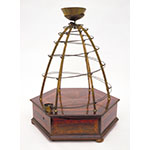This apparatus is extremely rare: the only other known example, now at the University of Padua, originally belonged to Giovanni Poleni's Teatro di Filosofia Sperimentale. The device was invented in 1699 by Jean Truchet to demonstrate Galileo's law of falling bodies along an inclined plane. It provides an experimental demonstration of the acceleration of natural motion using an equivalent but different approach with respect to the inclined plane inv. 1041.
The apparatus consists of a hexagonal wooden base to which are fastened six curved brass bars that join in a common apex, forming a paraboloid. A pair of metal wires is wound in a spiral around the paraboloid, forming a track that rises from the base to the top of the device. At the apex of the paraboloid is a cup with a hole connecting it to the spiral track. A brass plumb line (now missing) ensured the perfect verticality of the device, a prerequisite for the experiment's success.
A ball is dropped down the track. When the ball has completed the first turn of the spiral, the second ball is released. We observe that each turn, whose length increases in the sequence of odd numbers beginning with 1, is covered by both balls in equal times, exactly as predicted by Galileo's law of natural motion. The base of the apparatus conceals a clockwork mechanism fitted with a spoon that reactivates the experiment by releasing the ball again. Provenance: Lorraine collections.










